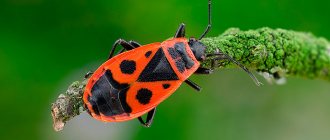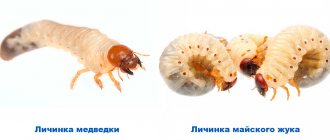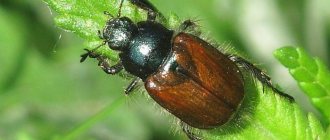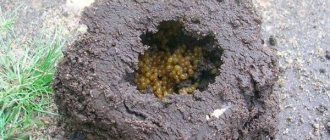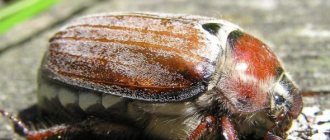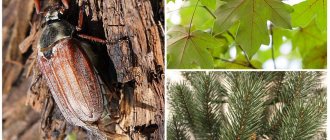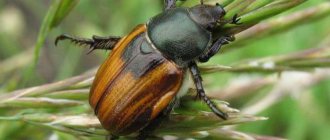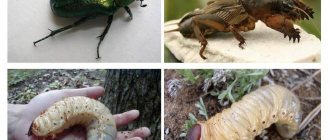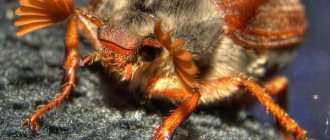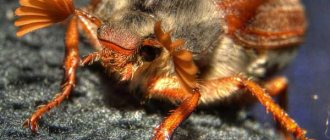If many have not seen this large insect, they have probably heard of it. With the onset of spring warmth, clouds of beetles circle above the flowering trees with a loud buzzing sound. One of the most malicious pests, which can be combated using a variety of methods. Voracious insects and their offspring are capable of destroying plantings over vast areas in the shortest possible time. The population multiplies rapidly, regardless of region or weather conditions.
The time of May beetles is May and April, this is the most active time for their life activity, hence the name. During this period, pests actively eat the pulp of flowering buds and soft young leaves, destroying trees, shrubs, and all flowering plants. Large individuals are capable of destroying young trees, eating not only leaves, bark and branches.
Chafer
The cockchafer belongs to the order of Coleoptera insects. There are two types: brown and black. Most of us are familiar with them by their characteristic glossy shiny brown shell on the back. Another common arthropod insect is called Khrushchev.
Description
What does a cockchafer larva look like? The larvae grow up to 4-7 cm in length , they have a massive elongated body of a light yellow-milky color (as seen in the photo below), covered with sparse hairs, while the tail part is slightly enlarged and darker.
May beetle larva - photo:
If you visually compare the larva and the adult beetle, the former will be slightly larger than the adult in size. The wrinkled body is crowned by a rounded head, often red or yellowish in color, equipped with two brown antennae and small mandibles, which help not only grind food, but also dig the ground.
The larva is completely blind , which is due to its underground lifestyle. The larva has to navigate through its maximally developed sense of smell and touch.
In the front part of the body there are 6 grasping legs. On the sides in one row you can see small brown marks , like eyes. In a calm, lying state, the body of the larva takes on a C-shape.
Stages of development
Like any insect belonging to the arthropod family, Khrushchev reproduces sexually. The appearance of an adult individual refers to a variant of indirect development with complete transformation. The beetle will go through the stages of egg, larva, pupa, and adult during its life. The duration of one generation is five years.
It is determined by climatic conditions and the amount of food. During this period, the following stages of development successively occur:
- Laying eggs. Burying herself in the ground, the female lays about 70 large eggs in mid-June. After this, her life ends. Males die even earlier.
- Appearance of the larva. They emerge from eggs at the end of summer completely different from the adult insect, neither in appearance nor in their mode of existence. The habitat of the larvae is the soil at different depths. This is due to age and time of year. For three years, they skillfully feed on the roots of grass, shrubs, and young fruit trees.
- Having lived three winters underground, having greatly increased their size, in the spring, going deeper into the ground, they take off their cover and turn into a pupa. Her appearance becomes similar to an adult Khrushchev. A strong chitinous cover appears, yet without coloration. She can't move. Nutrition occurs due to substances located under the chitinous dome. Only in the fall does the protective skin of the pupa crack and a beetle appears, hibernating underground and only the next year flying out into the wild. At this time, the color of its chitinous back is formed. A reddish tint is more common in insects living in places with little shade and in northern regions. In southern places, with dense vegetation, black cockchafers often live. The Western Khrushchev has a black chest under a brown, chitinous back. In April and early May, whole hordes of young, strong pests can attack almost any useful plant.
How to distinguish from a mole cricket?
How to distinguish a cockchafer larva from a mole cricket larva? The larva of the May beetle can only be confused with the bronze caterpillar and some other larvae. The second stage of mole cricket development after the egg resembles a smaller copy of the adult individual. Only the imago is much darker, and also has wings. The light-colored insect does not exceed 3 cm in size and looks very similar to a small mole cricket (see photo below).
It is necessary to remember the external characteristics of the cockchafer caterpillar so as not to confuse it with other, not at all dangerous larvae . For example, the bronze larva does not damage rhizomes, but enriches the soil with waste products, and is practically harmless . They can be distinguished by the color of the dots on their sides, small head and short light brown legs.
The larva of the May beetle and the mole cricket: what is the difference? Photo of mole cricket larvae:
What does it eat?
What do cockchafer larvae eat? If the imago individual has a relatively modest set of dishes, then the larva of the cockchafer is famous for its greater gluttony . Thanks to their strong jaws, the larvae eat solid plant food, sometimes chewing even the strongest roots of old trees.
At the beginning of its development, boroznyk feeds mainly on small rhizomes of plants and trees (cherry, larch, birch, spruce, oak, cedar, etc.), as well as plant humus.
With the onset of cold weather, the larva tends to move deeper underground (up to a meter) to wait out the cold, and by spring it rises again closer to the surface. There she will feast on the roots of bushes (black currant) and other plants, including vegetables .
Having reached 2 years, the larva begins to consume tree roots, bulbs, potato tubers, turnips , etc.
The fact that furrows were operating in the plantings can be understood by taking a closer look at the potato fruits - the tubers will be eaten away in a special way , and uneven edges will form around small voids. In the center of the seedling bushes, the leaves and stems will look lifeless and limp - this is a sure sign that larvae have infested under the roots.
Appearance of the May Khrushchev
The May beetle is a genus of Coleoptera insects, family – lamellar beetles. These are quite large insects up to 32 millimeters in size. The body is oblong-oval. The head is small, the mouthparts are of a gnawing type.
The main difference between a female and a male is the size and structure of the antennae. Males are characterized by the presence of 7 plates, while females have only six. Plus, the antennal plates of the female are almost half the size of those of the opposite sex.
There are two most common types of insects in Russia:
— Western May Khrushchev;
- Eastern May Khrushchev.
The western species lives mainly in the west of the Eurasian continent. The lower body, limbs and cephalothorax are black.
The range of the eastern May beetle extends from Yakutia and Beijing to Odessa and Zaporozhye in the west. Legs and antennae are red-brown. The cephalothorax can be colored from black to red-brown. Oriental Khrushchev causes enormous damage to young coniferous plantations in Siberia. By destroying the roots of young pines, the beetle larvae lead to their mass death.
The larvae of both species have a similar structure. The color is white, the body shape is most often C-shaped. The head is brown with a formed gnawing apparatus of yellow-brown color. There are three pairs of limbs, no pseudopods.
Reasons for the appearance of the pest on the site
Paradoxically, cockchafers primarily threaten well-groomed and cultivated areas. They prefer light soils, such as sandy soils, and are much less likely to appear in areas with heavy clay soils. It is easier for females to lay eggs in loose soil, and it is more convenient for larvae to exist in it.
Humidity and temperature are important for larvae. Thus, the close occurrence of groundwater or high soil moisture has a detrimental effect on insects. They also do not tolerate high temperatures well. If the thermometer shows more than +25⁰С, the insects go deeper into the ground.
Prevention measures
In order not to have to fight cockchafers and their larvae, it is wiser to take some measures to prevent the appearance of insect pests on the site. To do this, it is necessary to mulch the soil in a timely manner. Crushed bark, eggshells, straw, wood shavings and other materials prevent adults from penetrating the soil and laying eggs there.
You can scare away cockchafers by burying cabbage leaves or mustard shoots between the rows. It is recommended to plant plants from the Cruciferous family, turnips, turnips or elderberries along the perimeter of the beds.
Khrushchev larvae like to climb into compost heaps for the winter. Therefore, to prevent their appearance next year, it is necessary to lay a piece of film under it. It will prevent insects from getting into the ground. And with the onset of frost, the compost needs to be scattered. Then all the larvae will die from the cold.
Signs of plant infection
Adult beetles eat the foliage of trees and shrubs. To a lesser extent, they can eat the ovaries, buds and flowers of plants. The larvae are more voracious, but they are limited in movement, so they feed mainly on the roots of plants, which are easiest for them to reach.
The main symptom of infection is the presence of larvae or a clutch of eggs in the soil (caterpillars can also be on the lower part of the stem). But there are other signs that voracious pests are operating in the area:
- growth slows down;
- plants (especially young ones) begin to wither and are easy to remove from the ground;
- There are either no flowers and fruits at all, or much less than usual.
Sometimes the stems of affected plants darken and dry out.
Damage from cockchafer larvae
The greatest danger to the crop is not the beetles themselves, but their larvae. Adults located on the surface are easy to see and their activities can be stopped in time. They live underground, so at first the damage they cause to plants is unnoticeable. Moreover, in just a day, one three-year-old insect can destroy the roots of a young seedling.
The diet of larvae is very diverse and includes many crops:
- roots of trees of various coniferous and deciduous species, shrubs;
- strawberries and wild strawberries;
- seedlings of various vegetables, potatoes and corn;
- herbaceous plants.
Ways to fight
Fortunately, there are several methods available to eliminate these pests. The marbled beetle has long been an annoyance to farmers; they fought its larvae with folk remedies. It should be said that these methods of combating Khrushchev still give good results today.
With the development of science, chemical agents appeared. In recent years, biologically active preparations have been invented that make it possible to destroy cockchafer larvae without causing any harm to plants. If there are too many insects on the site, then in this case it is necessary to take comprehensive measures.
It is important to know that it is best to combat dangerous cockchafer larvae with the onset of warm weather, when they are very close to the soil surface.
Folk methods of struggle
How to cultivate the land to avoid unpleasant insects? The most effective methods are:
- Bleach solution. To prepare the product, you need to dilute 100 grams of water in a bucket. bleach and treat the soil around berry bushes or between rows of garden plants with this liquid. Of course, this method cannot be called environmentally friendly, but with such a low concentration of chlorine, the negative impact on the soil will be minimal. It is important not to pour the solution closer than 10 cm from the roots.
- An infusion of onion peels with iodine is absolutely harmless to the plant world, but it successfully removes dangerous insects from the area. The preparation is very simple. You need to fill a bucket with onion peels about a third and fill it with water to its full capacity. The product should be infused for five days. To avoid water evaporation, it is better to place the bucket in a dark place and cover it with a lid. After this period has expired, the infusion is filtered and squeezed. Before use, it must be diluted with water in a 1:1 ratio. Water the soil with this liquid.
- A manganese solution is very helpful in saving potatoes from May beetle larvae. There is no need to do too much concentration; it should have a light pink color. The lower part of the potato bushes is sprayed with this liquid.
- A solution of ammonia or ammonia protects strawberries well. To prepare the product, you need to add only 15 ml of ammonia or ammonia to a bucket of water. It is better to use ammonia, as gardeners write in reviews, together with watering.
Fruit trees can be successfully protected from chafer larvae by planting some white clover around them. This plant actively releases nitrogen into the soil, which the larvae cannot tolerate.
What else are they afraid of?
It has long been noted that where elderberries, lupines, turnips or turnips grow, the larvae of the cockchafer do not live. These plants can be planted around the vegetable garden.
Another good tip. When digging up your site, do not be lazy to manually collect the larvae and destroy them. You will definitely come across them, because they are found at a maximum depth of 1 m.
How to collect larvae by hand
This method of eliminating insects is labor-intensive and requires a significant amount of time. It should be used in the summer, when the larvae are closest to the surface.
You should manually dig up the entire area to a depth of at least 10 cm and collect any pests found. The disadvantage of this method is that it does not guarantee the destruction of all larvae.
Sodding the area
In this case, we are talking about saturating the soil with nitrogen in a natural way. To do this, it is necessary to plant white clover in the area where the cockchafer larvae have settled. Special bacteria live on the root system of this grass. They saturate the soil with nitrogen by absorbing it from the air. The gas is transferred to other plants.
Khrushchev larvae do not survive in soil saturated with nitrogen. This gas is also harmful to some types of weeds. This method allows you to effectively and safely eliminate pests.
Preventing the appearance of larvae
Preventive measures against beetleworm larvae should be taken twice a year, namely in spring and autumn. For this, the folk methods discussed above are the best suited.
Mulching the soil is an excellent preventative measure. In early spring, even before the weather warms up, you need to sprinkle a layer of sawdust, shavings or regular straw on the area. This prevents female cockchafers from penetrating the soil to lay eggs.
To protect fruit trees from adult cockchafers, you can use simple traps made from plastic bottles. To do this, the bottom part of the bottle is cut off by a third, and the cork remains in the screwed position. Traps need to be hung on the branches and a little kvass or sour jam should be poured into them, yeast should be added and slightly diluted with water. June Khrushchev loves this smell very much, but after trying this drink, it immediately dies. All you have to do is periodically shake out the dead beetles from the traps.
Chemicals
Such anti-khrushchev drugs can only be used if absolutely necessary. Each package of insecticides must contain instructions for use. It must be strictly observed. There are a lot of chemical poisons for protecting plants from pests. Below we provide a small list of the most effective of them.
- “Zemlin” is produced on the basis of diazinon and is intended to poison pests living specifically in the soil.
- "Bazudin" has similar properties, but lasts much longer than "Zemlin".
- “Pochin” is produced in the form of small granules that can be used when digging the soil. The drug is also produced on the basis of diazinon.
- "Aktara".
This insecticide is one of the most popular among gardeners, like Vallar. It can be used both for spraying plants and for applying to the soil. The poisonous substance in it is thiamethoxam. - "Antikhrushch" has a contact and systemic effect on pests living in the soil.
- “Prestige”, “Gromoboy”, “Gromoboy-2”, “Medvedox”. These drugs have virtually the same properties. The difference in name is explained by the commercial interests of the manufacturers. The degree of impact on pests is the same for all of these products. They are introduced into the soil long before planting.
Review of effective insecticides:
- "Antikhrushch" is diluted according to the instructions, 100 ml per 10 liters. water. The solution is poured under each bush at the rate of 30-50 ml. The effect lasts up to 45 days, but for early ripening crops, a similar drug is used only after harvesting.
- "Aktara" also has a long-lasting effect (from 40 to 100 days), so it is used in mid-summer. Not suitable for remontant varieties of strawberries or raspberries. The method of application includes treating the roots of plants before planting, as well as spilling the soil.
- "Karbofos" is usually used to process potatoes. The validity period of the drug allows it to be used during planting (not for early varieties), and it provides a complex effect against different types of garden parasites.
Bacteriological preparations are popular. Insecticides such as “Nemabakt” or “Antonem-F” contain nematode bacteria that settle in the body of the worm and lead to its death. They are not dangerous for plants, animals or humans; use is carried out according to the instructions for the specific drug.
Traps
To prevent larvae from appearing in the garden, it is important not to create favorable conditions for the existence of adult individuals. They can be caught using special traps.
To make a light trap, you will need a wide jar, at the bottom of which you need to pour sweet syrup from diluted jam or honey. A cone made of rolled paper or a cut plastic bottle should be placed in the neck. A light source must be suspended above the resulting funnel.
Trap against cockchafer: 1 - light source, 2 - funnel, 3 - glass jar
The prepared structure must be taken out into the garden overnight. Attracted by the light and sweet aroma, insects will climb inside the jar and will not be able to get out. In the morning they should be collected and destroyed.
It is much easier to make a trap from newspapers or paper sheets. They should be smeared with some sweet and sticky substance and placed between strawberry rows or hung on trees. Pests attracted by the sweet smell will get stuck in the sticky mass.
In the mornings, when the air temperature does not rise above +15 degrees, cockchafers are inactive. At this time, they can simply be shaken off trees and bushes, collected by hand and fed to animals.
Biologically active methods
The best biological preparation for the destruction of beetle larvae is Nemabact. It goes on sale in the form of an aqueous suspension containing nematode bacteria. They are deadly to larvae. The uniqueness of the drug is that the nematodes remain alive for two years after applying the drug to the soil. No plant protection product has a longer lasting effect.
Nemabact only affects insects and does not cause any harm to the environment. It is not dangerous for people, animals, or plants.
Natural enemies
You can entrust the collection to “professionals” - to attract natural enemies to the site: starlings, rooks and other birds. Despite its effectiveness, this method is fraught with unpleasant consequences - damage to the harvest of fruit trees, because many birds are not averse to profiting from ripe berries and fruits.
Hedgehogs also love to eat garden pests.
In summer cottages and suburban “haciendas”, many gardeners specifically attract these helpers.
How to deal with pests?
Gardeners use comprehensive control measures. In late spring and summer, the larvae crawl closer to warmth, and at this time they dig the ground for planting. It is easy to find them on the surface and destroy them, the number is significantly reduced. Khrushchev do not like nitrogen; experienced gardeners recommend planting white clover around the perimeter of the territory, which makes nitrogen available to the soil.
Insects do not like the smells of lupine, elderberry and cruciferous vegetables (various varieties of cabbage). Attract starlings to the area and feed hedgehogs. Treat the ground with a solution of onion peels. Add husks 1/3 full into the bucket, cover with warm water and leave for 5 days. After this, dilute the solution with water 1:1 and water the soil.
Use industrial insecticides between the rows: Antikhrushch, Nemabakt, Bazudin, Zemlin. They rid greens of pests and are also safe for pets and humans.
Source: adella.ru
How do you like the article?
Saving strawberries from the cockchafer
Khrushchev larvae most often cause damage specifically in strawberry plantings. The vegetation cycle of this plant is approximately 4-5 years, during which the soil is not completely dug up, so the risk of pests is very high. Voracious worms destroy plantings very quickly.
The main sign of damage is the death of several plants for no apparent reason. The bushes begin to wither and dry out, and when digging, you can discover the absence or damage of the roots, or the culprit itself - a large white larva of a curved shape.
To prevent the crop from being damaged, you can use the following recipes.
Effective ways to protect strawberries from beetleworm:
- Plant plants that repel cockchafers between the rows. These are fragrant marigolds, white clover, cabbage, radishes (radishes) or onions.
- Mulching the soil in the beds repels females, preventing them from laying eggs. For this, sawdust from coniferous trees, straw or dry pine needles are used.
- Periodically, plantings can be sprayed with a weak solution of potassium permanganate, as well as an infusion of onion peels.
- Change the planting site when updating the crop. It is better to allocate a different place for strawberries each time, carefully digging and treating the planting site with insecticides. Until the period of fruiting of young plants, there will be no trace of chemical compounds left, and the soil will be disinfected from larvae and eggs for at least a year.
- Prepared solutions of insecticides can be spilled between the rows, providing protection from pests, and folk recipes can be used directly on the beds themselves.
When planning to transplant bushes, be sure to check the soil; usually the larvae are located at a depth of 30-40 cm from the surface. Digging allows you to get rid of the bulk of the larvae, and the methodical destruction of adult beetles in the spring prevents the appearance of new insects.
What do larvae eat at home?
Khrushchev bait.
Fishermen are very happy with the beetle larvae. These thick worms make excellent bait. Therefore, many fishermen collect them in the fall and leave them until spring.
In such cases, they are placed in a jar with sawdust and lowered into the cellar so that the larvae feel as if they were in their natural environment in winter. In the spring, before the planned start of fishing, the container with additional food is taken out and cottage cheese is added. From such food, the beetles become large and white - an excellent bait.
How to protect potatoes from Khrushchev
Potato tubers are often affected by this pest. Severe contamination of the soil can lead to the complete destruction of the crop; in addition, the potatoes will not be stored, so all summer work will be wasted. Simple methods of combating the cockchafer will help prevent this.
How to get rid of larvae in potato beds:
- Combine annual digging of the soil with the selection of larvae.
- Plant beetle repellent plants between the rows.
- Pour a little dry mustard into each well.
- Plant green manure plants in the garden beds in the fall.
- Use chemicals for severe lesions.
The fight against cockchafers must be carried out methodically, using all possible methods. You should not assume that the absence of larvae last year will protect the crop for a long time, because new pests will not keep you waiting.
How long does the larva grow and the damage it causes?
The development process of the cockchafer larva is very long - it lives underground for about 4 years, then pupates at a depth of 30-50 cm and turns into a beetle. This is the final stage of development, which usually occurs at the end of summer or the first month of autumn.
Young cockchafers spend the winter in the ground, and when spring comes, they come out again to mate and have offspring. The number of beetles is favorably influenced by good weather. Their active life continues for several years.
Any soil is suitable for the larva to live, but it often gives preference to places where fresh manure has been applied. Large individuals (4 to 7 cm long, which exceeds the size of the cockchafer itself) can gnaw potato tubers and harm strawberry and berry bushes. Of the trees, the larvae prefer to live under apple trees, pears and apricots. After damage to the root system, many leaves become limp and dry out, and the plant often dies.
Interesting!
According to biologists, a 3-year-old cockchafer larva is capable of eating all the roots of a young tree within a day.
Older larvae are capable of causing enormous damage to the crop, damaging the roots of vegetable and garden plantings. Therefore, it is so important to get rid of the cockchafer larvae in time before they destroy the future harvest.
Ways to combat adult May beetles
The most commonly used methods are:
- Mechanically shaking off insects in the morning. Now they are not active and are in a state of sleep. They can be caught directly from the branches of low bushes and trees.
- Planting lupine. The real poison for them is lupine. May beetles avoid areas with this plant.
- Using bright light. Special traps are a shallow container in which a small light source is placed. The walls are covered with a sticky liquid. In the evening the trap is placed in the garden. In addition to beetles, other pests also get into it. You can cover the newspaper with sticky fly tape and place it in a place where beetles accumulate. They quickly detect the trap and stick to its surface.
- Chemical methods. The drugs Antikhrushch, Aktara, Zemlin, Bazudin are not effective; they are used with extreme caution in gardens and vegetable gardens of industrial plantations.
- Biological methods. New drugs such as Nemabact make it possible to destroy the beetle in the larval phase. It consists of a nematode worm that lives in the soil and feeds on larvae. The drug is harmless to people and animals.
Tips and tricks
The main simple but useful recommendations include the following tips, known from the experience of site owners:
- Along the borders of the site, plant perennial bushes of decorative lupine as beautiful flowering flower beds.
- Annually plant marigolds, nasturtium, calendula or other repellent plants along the edges of vegetable beds.
- Use low-growing marigolds as green manure plants. In the fall, bury them in the ground in the planned bed.
- Use white clover in the trunks of fruit trees. This will destroy the larvae, reduce the growth of weeds and add essential microelements obtained naturally to the soil.
- Treat the row spacing with a 70% karbofos solution.
- Water the plantings with a weak solution of ammonia at the rate of half a tablespoon per bucket of water.
Everything that is created by nature is not only harmful, but also necessary. So is this beetle. Traditional healers use it in recipes for certain diseases. Fishermen will not refuse tasty bait when fishing for chub. Numerous amphibians and birds use it as a high-calorie food.
Sources
- https://rusfermer.net/ogorod/vrediteli/majskij-zhuk/lichinki/opisanie.html
- https://obnaruzhil.ru/zhuk/lichinki-majskogo.html
- https://WikiParazit.ru/zhuki/otlichiya-lichinok-mayskogo-zhuka-i-medvedki.html
- https://vusadebke.com/boryba-s-vreditelyami/vrediteli/lichinka-mayskogo.html
- https://sovusadba.ru/vrediteli-i-bolezni/kak-vyglyadit-lichinka-majskogo-zhuka-na-foto-i-po-opisaniyu.html
- https://bezbukashek.ru/drugie/lichinki-majskogo-zhuka-kak-s-nimi-borotsja-7-luchshih-metodov
[collapse]
